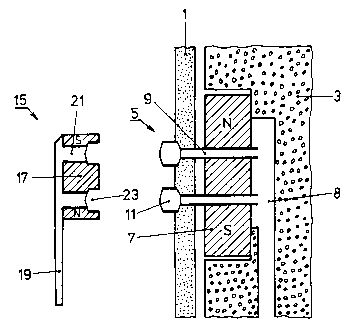Une partie des informations de ce site Web a été fournie par des sources externes. Le gouvernement du Canada n'assume aucune responsabilité concernant la précision, l'actualité ou la fiabilité des informations fournies par les sources externes. Les utilisateurs qui désirent employer cette information devraient consulter directement la source des informations. Le contenu fourni par les sources externes n'est pas assujetti aux exigences sur les langues officielles, la protection des renseignements personnels et l'accessibilité.
L'apparition de différences dans le texte et l'image des Revendications et de l'Abrégé dépend du moment auquel le document est publié. Les textes des Revendications et de l'Abrégé sont affichés :
| (12) Demande de brevet: | (11) CA 2456849 |
|---|---|
| (54) Titre français: | ACCES PERCUTANE ET TRANSCUTANE A L'INTERIEUR DU CORPS |
| (54) Titre anglais: | PERCUTANEOUS OR TRANSCUTANEOUS ACCESS TO THE INTERIOR OF THE BODY |
| Statut: | Réputée abandonnée et au-delà du délai pour le rétablissement - en attente de la réponse à l’avis de communication rejetée |
| (51) Classification internationale des brevets (CIB): |
|
|---|---|
| (72) Inventeurs : |
|
| (73) Titulaires : |
|
| (71) Demandeurs : |
|
| (74) Agent: | ROBIC AGENCE PI S.E.C./ROBIC IP AGENCY LP |
| (74) Co-agent: | |
| (45) Délivré: | |
| (86) Date de dépôt PCT: | 2001-08-14 |
| (87) Mise à la disponibilité du public: | 2001-11-08 |
| Licence disponible: | S.O. |
| Cédé au domaine public: | S.O. |
| (25) Langue des documents déposés: | Anglais |
| Traité de coopération en matière de brevets (PCT): | Oui |
|---|---|
| (86) Numéro de la demande PCT: | PCT/CH2001/000499 |
| (87) Numéro de publication internationale PCT: | WO 2001083023 |
| (85) Entrée nationale: | 2004-02-06 |
| (30) Données de priorité de la demande: | S.O. |
|---|
L'invention concerne un agencement de liaison percutané ou transcutané, comprenant au moins un passage ou une liaison sans passage à travers la surface externe d'un être vivant, notamment la peau. Cet agencement de liaison comporte un aimant permanent (7), placé dans la zone de la surface externe, par exemple la peau (1, 3), et dont le pôle est agencé de façon décalée et le plus parallèle possible à ladite zone. Dans le cas d'un agencement de liaison percutané, des passages physiques (9) traversent la surface externe de l'être vivant, alors que dans un agencement de liaison transcutané, la transmission de signaux électriques, électromagnétiques et/ou d'énergie électrique s'effectue sans passage, par exemple au moyen de bobines.
The invention relates to a percutaneous or transcutaneous connection system
which comprises at least one passage or a connection devoid of such a passage
through the external surface of a living thing, such as in particular the
skin. Said system has a permanent magnet (7) that is located in the region of
the external surface such as the skin (1, 3) with its poles running
substantially parallel to the latter. In the case of a percutaneous connection
system, physical passages (9) which traverse the external surface of the
living thing are provided, whereas in a transcutaneous connection system,
electric or electromagnetic signals and/or electric energy are transmitted
without the aid of such passages, for example, using coils.
Note : Les revendications sont présentées dans la langue officielle dans laquelle elles ont été soumises.
Note : Les descriptions sont présentées dans la langue officielle dans laquelle elles ont été soumises.

2024-08-01 : Dans le cadre de la transition vers les Brevets de nouvelle génération (BNG), la base de données sur les brevets canadiens (BDBC) contient désormais un Historique d'événement plus détaillé, qui reproduit le Journal des événements de notre nouvelle solution interne.
Veuillez noter que les événements débutant par « Inactive : » se réfèrent à des événements qui ne sont plus utilisés dans notre nouvelle solution interne.
Pour une meilleure compréhension de l'état de la demande ou brevet qui figure sur cette page, la rubrique Mise en garde , et les descriptions de Brevet , Historique d'événement , Taxes périodiques et Historique des paiements devraient être consultées.
| Description | Date |
|---|---|
| Inactive : CIB de MCD | 2006-03-12 |
| Inactive : CIB de MCD | 2006-03-12 |
| Inactive : CIB de MCD | 2006-03-12 |
| Le délai pour l'annulation est expiré | 2005-08-15 |
| Demande non rétablie avant l'échéance | 2005-08-15 |
| Réputée abandonnée - omission de répondre à un avis sur les taxes pour le maintien en état | 2004-08-16 |
| Inactive : Page couverture publiée | 2004-03-30 |
| Lettre envoyée | 2004-03-26 |
| Inactive : Notice - Entrée phase nat. - Pas de RE | 2004-03-26 |
| Demande reçue - PCT | 2004-03-10 |
| Exigences pour l'entrée dans la phase nationale - jugée conforme | 2004-02-06 |
| Demande publiée (accessible au public) | 2001-11-08 |
| Date d'abandonnement | Raison | Date de rétablissement |
|---|---|---|
| 2004-08-16 |
Le dernier paiement a été reçu le 2004-02-06
Avis : Si le paiement en totalité n'a pas été reçu au plus tard à la date indiquée, une taxe supplémentaire peut être imposée, soit une des taxes suivantes :
Veuillez vous référer à la page web des taxes sur les brevets de l'OPIC pour voir tous les montants actuels des taxes.
| Type de taxes | Anniversaire | Échéance | Date payée |
|---|---|---|---|
| Enregistrement d'un document | 2004-02-06 | ||
| Taxe nationale de base - générale | 2004-02-06 | ||
| TM (demande, 2e anniv.) - générale | 02 | 2003-08-14 | 2004-02-06 |
Les titulaires actuels et antérieures au dossier sont affichés en ordre alphabétique.
| Titulaires actuels au dossier |
|---|
| PHONAK AG |
| Titulaires antérieures au dossier |
|---|
| CHRISTOPH HANS SCHMID |
| HERBERT BAECHLER |